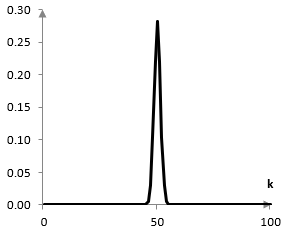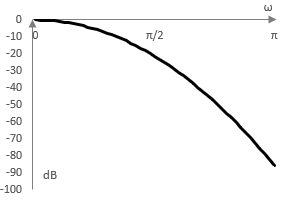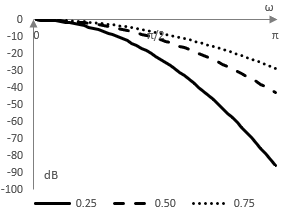The Gaussian filter is usually described by the formula
$$\sqrt{\frac{\alpha}{\pi}} \, e^{-\alpha \, x^2}$$
where α > 0 (typically, as below, 0 < α < 1).
As a discrete time filter of length N with coefficients that are symmetric around the middle, the coefficients of the Gaussian filter are as follows.
The coefficients of the Gaussian filter are
$$\sqrt{\frac{\alpha}{\pi}} \, e^{-\alpha \, (k-\frac{N-1}{2})^2}$$
where N is the length of the filter, k = 0, 1, …, N – 1, and 0 < α < 1.
The following is the impulse response of the filter, at N = 101 and α = 0.25.

The Gaussian filter as a low pass filter or a high pass filter
As defined, the Gaussian filter is a gentle low pass filter. The magnitude response of this filter at frequency f (computed the magnitude of its Fourier transform) is
$$|H(f)|=e^{-\frac{(\frac{2 \, \pi \, f}{f_s})^2}{4 \, \alpha}}$$
where fs is the sampling frequency. This follows directly from the known Fourier transform of the Gaussian function.
In terms of the angular frequency ω, the magnitude response of the filter is
$$|H(f)|=e^{-\frac{\omega^2}{4 \, \alpha}}$$
For a given α, this magnitude response decreases slowly as f (or ω) increases. Because of this gradual reduction of higher frequencies, two dimensional Gaussian filters are used in image processing for blurring.
For example, with N = 101 and α = 0.25, the magnitude response is as follows.

Since this is a finite impulse response filter with coefficients that are symmetric around the middle, this filter can be inverted into a high pass filter, similarly to the standard sinc high pass filter (see High pass filter).
Gaussian filter with different α
With larger α, the lobe of the impulse response of the filter becomes narrower. The magnitude response of the Gaussian filter decreases more slowly as the frequency increases. The following is the magnitude response of the filter for three values of α: 0.25, 0.50, and 0.75.

See also:
Gaussian window
Add new comment